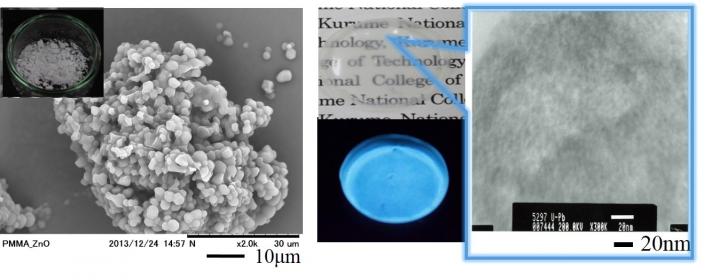Semiconductor nanoparticles show high luminescence in a polymer matrix

Polymer-ZnO nanoparticle QDs by dispersion polymerization in supercritical CO2 are shown. COPYRIGHT (C) 2015 TOYOHASHI UNIVERSITY OF TECHNOLOGY. ALL RIGHTS RESERVED.
Semiconductor nanocrystals known as quantum dots (QDs) are increasingly being used as photoluminescent materials in bio-imaging, photonics, and optoelectronic applications.
However, these QDs must have stable photoluminescence properties to be used in these applications. Photoluminescence stability of QDs is achieved by chemically modifying the surface of the QDs.
However, chemical modification of the surface typically requires large amounts of organic solvents that are harmful to the environment. To solve this problem, many researchers have attempted to synthesize polymer-nanoparticle composites by using supercritical fluid (SCF)-based technology.
Supercritical CO2 has emerged as the most extensively studied SCF medium, because it is readily available, inexpensive, nonflammable, and environmentally benign.
Toyohashi Tech researchers in cooperation with researchers at the National Institute of Technology, Kurume College have investigated the formation of nanostructured material using supercritical CO2.
They have demonstrated the formation of composite nanoparticles of luminescent ZnO QDs and polymer by dispersion polymerization in supercritical CO2. As a result of the supercritical-CO2-assisted surface modification of QDs, the QDs were well dispersed in the polymer matrix and showed high luminescence.
“Unfortunately, the photoluminescence properties of pristine luminescent QDs were quenched in supercritical CO2. The surface structure of the QDs was destroyed by supercritical CO2.”, explains associate professor Kiyoshi Matsuyama at the National Institute of Technology, Kurume College, “We found that the quenching of ZnO QDs could be prevented by coating with silica to obtain PMMA-ZnO composite QDs with high luminescence using a supercritical-CO2-assisted surface modification with polymer.”
Our research shows that the supercritical-fluid-assisted process provides an environmentally benign route for producing stabilized luminescent materials.
###
Reference:
Kiyoshi Matsuyama, Yu-ki Maeda, Takaaki Matsuda, Tetsuya Okuyama, Hiroyuki Muto (2015)
Formation of poly(methyl methacrylate)-ZnO nanoparticle quantum dot composites by dispersion polymerization in supercritical CO2, The Journal of Supercritical Fluids, 103, 83-89.
This article was identified as the “Editor-in-Chief's Featured Article.” http://www.
Related studies are featured in the September 2015 issue of TUT Research:
e-newsletter from Toyohashi University of Technology
Media Contact
Michiteru Kitazaki
press@office.tut.ac.jp
Media Contact
All latest news from the category: Materials Sciences
Materials management deals with the research, development, manufacturing and processing of raw and industrial materials. Key aspects here are biological and medical issues, which play an increasingly important role in this field.
innovations-report offers in-depth articles related to the development and application of materials and the structure and properties of new materials.
Newest articles

First-of-its-kind study uses remote sensing to monitor plastic debris in rivers and lakes
Remote sensing creates a cost-effective solution to monitoring plastic pollution. A first-of-its-kind study from researchers at the University of Minnesota Twin Cities shows how remote sensing can help monitor and…

Laser-based artificial neuron mimics nerve cell functions at lightning speed
With a processing speed a billion times faster than nature, chip-based laser neuron could help advance AI tasks such as pattern recognition and sequence prediction. Researchers have developed a laser-based…

Optimising the processing of plastic waste
Just one look in the yellow bin reveals a colourful jumble of different types of plastic. However, the purer and more uniform plastic waste is, the easier it is to…



